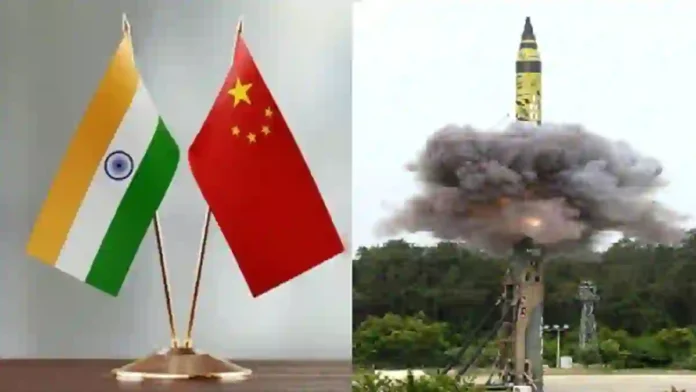The word ‘nuclear’ has been a taboo in New Delhi ever since the Strategic Forces Command (SFC) was established in India post-Pokhran nuclear tests in 1998.
On the 25th anniversary of ‘Operation Shakti,’ India’s Ministry of Defence (MoD) issued a statement for the ‘exemplary performance’ of SFC during 2021-22, when India was at loggerheads with China along the disputed border, the line of actual control or the LAC.
MoD’s press wing, DPR (Department of Public Relations), in an official statement last week (on 11 May), informed that Chief of Defence Staff (CDS) Gen Anil Chauhan had “conferred CDS unit citation award” to the SFC for exemplary performance in the year 2021-22 in a ceremony held in the capital New Delhi.
Apart from SFC, two other tri-service units and establishments–2 Para (Special Forces unit) and College of Defence Management, Secunderabad were also conferred with the CDS award in the ceremony.
The CDS unit citations award was constituted after the establishment of the Office of Chief of the Defence Staff (CDS) in 2019 to boost jointness and integration in the Armed Forces.
It was decided to award the selected tri-service units and establishments which function directly under the Chiefs-of-Staff Committee biennially as an incentive to excel as joint & integrated entities.
SFC is a tri-service nuclear command formed in 2003 for managing and administrating India’s nuclear stockpile. It consists of officers and personnel of the Indian Army, Indian Air Force (IAF), and Indian Navy who are deputed from their respective services.
The Commander-in-Chief (CinC), a 3-star General, is appointed on a rotational basis from the three services. India presently has two tri-service commands, another being Andaman Nicobar Command (ANC) beside SFC.
SFC works directly under the Nuclear Command Authority headed by the Prime Minister, with all three service chiefs being its member besides Defence Minister and National Security Advisor (NSA). Few know the headquarters of the SFC and the officers serving there. Even its insignia is not much seen.
During one of the visits to Arunachal Pradesh, adjoining LAC in the northeast region of India, the author had seen the SFC insignia at a forward military base indicating strategic weapons are deployed in the nearby areas.
The insignia is a tri-service emblem of two cross swords (of the Indian Army), an eagle (representing IAF), and an anchor (Navy) with the Sanskrit motto written ‘Brahmana Amitraan Khisnomi.’ The meaning of the motto can be roughly translated to “Kind people rise raising the flag and attack the violent dacoits (enemies) without any ideals.”
Read More– Indian soldiers may soon get jet pack suits to defend borders with China, Pak
Though India has never disclosed its nuclear stockpile, however, as per the Stockholm International Peace Research Institute (SIPRI) report of 2021, India has 156 nuclear weapons while China has 350 and Pakistan has 165.
“No country in the world openly declares fully about its nuclear policy or weapons but for the operational requirement keep signaling to the world about its nuclear force,” says Rajiv Nayan, Senior Research Associate at the Nuclear and Arms Control Centre of the Delhi-based Manohar Parrikar Institute of Defence Studies and Analysis (MP-IDSA).
“SFC has been in place for the past two decades, but what we see can be just the tip of the iceberg,” Rajiv Nayan told EurAsian Times.
“While operational details about SFC couldn’t be divulged, it’s necessary to give a message to the adversaries so as not to indulge in any kind of misadventure,” said Nayan, who has edited a book on the nuclear non-proliferation treaty of India during his long association at MP-IDSA, a government think tank on defense issues of the country.
In the year 2021-22, India was locked in a ‘no war, no peace situation with neighboring China post-Galwan Valley skirmish at the Line of Actual Control (LAC), the disputed border along Eastern Ladakh.
Since then, the relations between the two nuclear Asian countries have been ‘abnormal’ along the disputed border, the LAC.
Both India and China deployed about 50 thousand soldiers along the LAC in Eastern Ladakh beside the mechanized forces, artillery guns, fighter jets, and missiles (and the strategic weapons, too, it’s always believed).
Read More– Indian Navy test-fires BrahMos supersonic cruise missile from mormugao warship
Read More– India Plans Deeper Connectivity With Middle East To Counter China’s Footprint In Gulf
While India has Agni series of land-based ICBMs (Inter Continental Ballistic Missiles), which can carry nuclear warheads up to a range of 5000-8000 km, IAF’s Rafale and Mirage fighter jets are nuclear-armed fighter bombers.
With the Indian Navy’s indigenous INS Arihant submarine capable of launching K4 ballistic missiles (range 3500 Kms), India’s ‘nuclear triad’ is now complete and in place.
India conducted nuclear tests on 11 May 1998 at the Pokhran field firing range in the Thar desert range of Rajasthan adjoining the Pakistan border. India carried out a total of 5 tests that ‘rocked’ the whole world, and even the US and its intelligence agency CIA could not track the nuclear tests.
The code for the successful test, sent by the Indian Army Engineers Regiment at the Raisina Hills, was ‘White House collapsed.’ Raisina Hills in Delhi houses the seat of power of India, including the Prime Minister’s Office (PMO) and South Block.
With this coded message, India declared itself a nuclear weapons state.
Sources- The Eurasian Times




